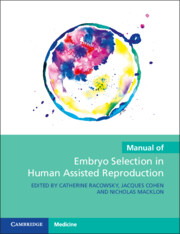Book contents
- Manual of Embryo Selection in Human Assisted Reproduction
- Manual of Embryo Selection in Human Assisted Reproduction
- Copyright page
- Contents
- Contributors
- Preface
- Chapter 1 Introduction
- Chapter 2 Embryo Developmental Programming
- Chapter 3 Embryo–Maternal Interactions
- Chapter 4 The Sperm’s Role in Embryo Development
- Chapter 5 The Oocyte’s Role in Embryo Development
- Chapter 6 The Laboratory’s Role in Embryo Development
- Chapter 7 Handling of Gametes and Embryos
- Chapter 8 Noninvasive Morphological Selection of Oocytes
- Chapter 9 Prospects for Bioenergetics for Embryo Selection
- Chapter 10 Static Morphological Assessment for Embryo Selection
- Chapter 11 Dynamic Morphological Assessment for Embryo Selection
- Chapter 12 Noninvasive Analysis of Embryo Nutrient Utilization for Embryo Selection
- Chapter 13 Genomics for Embryo Selection
- Chapter 14 Biopsy Techniques from Polar Body to Blastocyst
- Chapter 15 Cell-Free DNA Analysis for PGT-A
- Chapter 16 What Science May Come for Embryo Selection?
- Epilogue
- Index
- References
Chapter 9 - Prospects for Bioenergetics for Embryo Selection
Published online by Cambridge University Press: 26 April 2023
- Manual of Embryo Selection in Human Assisted Reproduction
- Manual of Embryo Selection in Human Assisted Reproduction
- Copyright page
- Contents
- Contributors
- Preface
- Chapter 1 Introduction
- Chapter 2 Embryo Developmental Programming
- Chapter 3 Embryo–Maternal Interactions
- Chapter 4 The Sperm’s Role in Embryo Development
- Chapter 5 The Oocyte’s Role in Embryo Development
- Chapter 6 The Laboratory’s Role in Embryo Development
- Chapter 7 Handling of Gametes and Embryos
- Chapter 8 Noninvasive Morphological Selection of Oocytes
- Chapter 9 Prospects for Bioenergetics for Embryo Selection
- Chapter 10 Static Morphological Assessment for Embryo Selection
- Chapter 11 Dynamic Morphological Assessment for Embryo Selection
- Chapter 12 Noninvasive Analysis of Embryo Nutrient Utilization for Embryo Selection
- Chapter 13 Genomics for Embryo Selection
- Chapter 14 Biopsy Techniques from Polar Body to Blastocyst
- Chapter 15 Cell-Free DNA Analysis for PGT-A
- Chapter 16 What Science May Come for Embryo Selection?
- Epilogue
- Index
- References
Summary
The role of ‘energy’ in the establishment and persistence of developmental competence for the growing and maturing oocyte and its ability to develop normally after fertilization has become a central focus of interest in understanding possible etiologies of outcome success or failure. This has become especially evident in the context of experimental studies that have applied costly, sensitive instrumentation to measure noninvasively, metabolic/respiratory activity levels in single oocytes and embryos for selective and diagnostic purposes. While the term energy is used freely in the clinical IVF literature, it is rarely defined or discussed in the context of how it can affect critical activities that are the foundation of embryo competence. Here, the intent is to familiarize the reader with current concepts related to cellular bioenergetics, and to evaluate the relative benefits and clinical applicability of current methods that have sufficient sensitivity for selective and diagnostic purposes of embryo viability. In particular, a low-cost observer-based autofluorescent method is described that may have direct application in this regard.
- Type
- Chapter
- Information
- Publisher: Cambridge University PressPrint publication year: 2023



